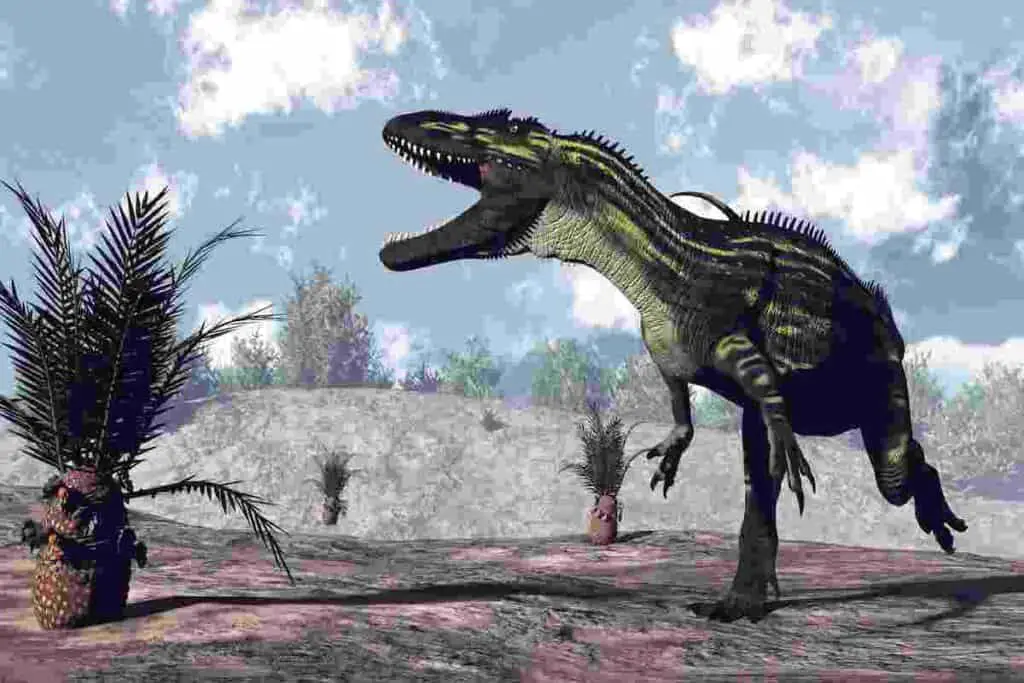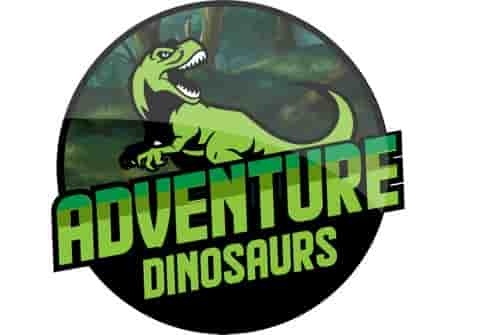The most famous dinosaur ever is probably T-Rex, which was a meat-eater and lived in North America. Many of the well-known dinosaurs from movies and discussed in the media are about North American dinosaurs. Across the pond, Europe was also crawling with a full ecosystem of dinosaurs similar to North America. It makes me wonder, what carnivorous dinosaurs lived in Europe?

What Were The Carnivorous Dinosaurs of Europe?
As a general rule, the key groups of carnivorous dinosaurs in Europe were Tyrannosaurids, Ceratosaurs, Megalosaurids, Allosaurids, and Maniraptoriformes. They lived at different periods during the Mesozoic Era—the largest carnivore found in the Torvosaurus, whose fossils have been found in Portugal and Germany.
During the Jurassic Period, Europe was a vast grouping of islands and an archipelago of isolated landmasses called ‘terranes.’ During the Late Jurassic Period, which lasted from about 145 million years ago to 140 million years ago, most of Europe was a subcontinent known as Laurasia. The Western European terranes broke off from North America and moved eastwards on the northern supercontinent Pangea.
Table of Contents
In the Cretaceous Period, Europe became an island continent. The climate was warmer during this period, and some dinosaurs roamed the land, which was similar to the ones found in North America. However, there was a varied mix of species that had evolved independently from those continents.
Let’s look now at the carnivorous dinosaurs who lived in those islands, representing Europe during the Mesozoic Era.
What Was the Largest Carnivorous Dinosaur in Europe? Different Types of Carnivore Dinosaurs
The largest dinosaur in Europe is the Torvosaurus gurneyi. Previously, paleontologists thought that the tyrannosaurid genus was the biggest meat-eater in Europe. Later, scientists found out that megalosaurids did well after Europe split from the larger Pangea.
Portugal’s Lourinha Formation preserved the fossils of a 32-ft Torvosaurus. Initially, they thought it belonged to the smaller tanneri species, but they concluded it was an undiscovered species: T. gurneyi. Though tyrannosaurids were historically bigger, they didn’t thrive as much as in Europe.
The first dinosaurs occupied a gigantic supercontinent called Pangea. Europe went with its fair share of carnivorous dinosaurs when Pangea split into multiple continents. They were smaller then, but some evolved into giant predators over millions of years. (Source)
Consequently, Europe shares similar dinosaur species with North America.
However, the continental split brought about some diversity. For example, megalosaurids in Europe grew more dominant in their niches than those in the United States.
The dinosaur subgroup Theropoda entails all the flesh-eating dinosaurs. Theropods were among the most diverse groups of dinosaurs. This subgroup was among the chicken-sized predators that preyed on tiny herbivores or omnivores. It evolved into the massive predators after splitting into the following clades:
- Tyrannosaurids
Dinosaur fans popularly refer to this clade as the tyrant lizards, among which Tyrannosaurus rex reigned. The biggest grew up to 40 feet. However, T. rex was uncommon in Europe.
- Ceratosaurs
- Megalosaurids
- Allosurids
- Maniraptoriformes
Baryonyx was one of the largest and most unique theropods. It existed in the Early Cretaceous period, and it was piscivorous. Scientists found fish scales in its stomach region.
This predator was slightly smaller than T. rex and moderately larger than Carnataurus. It was an excellent swimmer residing in island mashes.
The Torvosaurus genus is popular among fans that call it ‘the savage lizard.’ It existed about 150-168 million years ago. This genus deposited fossils all over the world. There’s prove it dwelled in Colorado, Germany, and Portugal.
This dinosaur was the King of Jurassic Europe. Torvosaurus was much bigger than its main European rival, Allosaurus europaeus. It averaged 3.6-4.5 tons, and it preyed on gigantic, long-necked herbivores.
Ironically, the dominance was reversed in North America. An American Allosaurus could easily overpower big Torvosaurus dinosaurs. (Source)
Where Have Carnivore Dinosaur Fossils Been Found in Europe?
Dinosaur fossils can be found all over Europe, especially in the United Kingdom or Portugal. Most dinosaur fossils were found in North America, but the Isle of Wight is the best place to find fossils in Europe.
According to fossil evidence, we can tell that the following carnivorous dinosaurs lived in the ancient United Kingdom:
- Baryonyx
- Becklespinax
- Camptosaurus
- Eotyrannus
- Eustreptospondylus
- Hypsilophodon
- Iguanodon
- Megalosaurus
- Proceratosaurus
- Metriaconthosaurus
- Sarcosaurus
- Neovenator
- Valdosaurus
Paleontologists theorize that Jurassic Britain was ideal for dinosaur domination. The famous T. rex even had about three cousins roaming in England.
The majority of English dinosaur bones were retrieved from the Isle of Wight, which produced the most fossils in Europe. Still, there’s an abundance of fossils extracted from Scotland, Wales, and Ireland. (Source)
The first-ever dinosaur fossil excavation was in 1824. Scientists found a Megalosaurus fossil in Oxfordshire.
Overall, Britain has produced more than 500 noteworthy dinosaur findings.
Portugal is also fossil-rich, and it even established an outdoor theme park. The outdoor museum features over 120 large-scale reproductions from a diversity of 70 dinosaur species. You can view a T. rex that stood four meters high. Most of the specimen fossils are from the Lourinha Formation.
France is also blessed with fossils of carnivorous dinosaurs. The Charente region preserved abundant fossil deposits, and the first excavations took place in the Audoin quarries.
The region has produced over 400 bones, contributing immensely to the knowledge of dinosaur predatory traits.
Spain also enjoys fossil findings from the Tremp Formation. This geological site in the Catalonian formation features fossils from the Cretaceous-Paleogene boundary. From the rich diversity of fossils, scientists can study over 1,000 dinosaur bones.
The site is also rich with well-preserved eggs and nesting sites.
Germany also hosted dinosaurs in the Jurassic era. The Altmuhltal Valley limestone quarries provide clues to the link between avian dinosaurs and birds.
However, the majority of fossils in German museums were collected from German colonial nations like Tanzania. The biggest fossils found were excavated from the Tanzanian Tendaguru Formation.
Notable Carnivorous Dinosaurs in Europe
Torvosaurus has to be the most famous carnivorous dinosaur that roamed Europe. This genus split into the biggest European predators of the Jurassic period:
Torvosaurus gurneyi (39 feet)
Torvosaurus tanneri (33 feet)
They killed differently. Gurneyi ripped off chunks of flesh and watched as the prey died in pain. The Torvosaurui killed its targets by crashing bones. Both were fuzzy, a trait that evolved into feathers. Torvosaurus was the most dominant megalosaurid in European history.
Baryonyx was notable enough to earn the moniker of ‘heavy claw.’ This magnificent predator enriched the dinosaur diversity in the ancient United Kingdom.
Baryonyx could grow over 33 feet long and had a large claw on its first finger. This spinosaurid crouched on riverbanks and grabbed fish with its long, slender snout.
Another amazing carnivorous dinosaur is the chicken-sized Compsognathus. It earned the alias ‘world’s smallest dinosaur.’ It was discovered in Germany, but smaller theropods were excavated in Northern America and Asia. Paleontologists believe they are relatives of T. rex that did not acquire gigantism.
These puny predators were vicious carnivores, and they dominated their feeding niche. They mostly ate non-dinosaurian lizards.
Scientists have studied Compsognathus fossils and found no evidence of primitive feathers. These species were actually among the first dinosaurs that eventually grew to become giant, apex predators.
Conclusion
The dinosaurs lived on this planet for millions of years, providing a wide variety of species. Europe was home to many carnivorous dinosaurs, from small and agile Compsognathus to giant Torvosaurus. The continent is also rich with fossils that help scientists understand more about these prehistoric creatures-their geographical presence, hunting habits, and other interesting finds.
It’s exciting to know that some of the same predators famous in North America had equivalent European carnivore hunters, even if they were different species. I hope that this article gives a small snapshot of the meat-eating dinosaurs in Europe.
